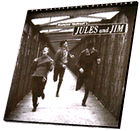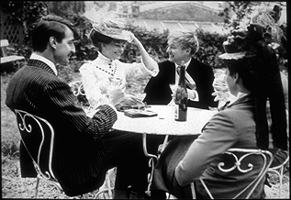

France film school
1962
bw 105 min.
Director: Francois Truffaut
CLV: $49.95 - available
1 disc, catalog # CC1308L
VHS: available from Home Vision Cinema

When Francois Truffaut
was a 21-year-old film critic, in 1953, he read a first novel by a 74-year-old
writer, Henri-Pierre Roche. "The book overwhelmed me," he later recalled, "and
I wrote if I ever principle. When Jim says he understands her, she replies, "I
don't succeed in making films I will make Jules et Jim. "Eight years
later -- want to be understood." And this is absolutely true. The movie lives
after constantly re-reading and even partly memorizing Roche's in the
shuddering distance between Catherine's imperious, doomed novel -- he more than
redeemed that promise. Sixties' audiences didn't merely see his movie, they
wanted to live it.Jules and Jim begins in Paris before World War I,
and introduces us to two aspiring writers. Jules is a shy, diminutive Austrian
(Oskar Werner is all pained charm), a born onlooker who masks his
aggressiveness as passivity. He can't get the girls, but his friend Jim can. A
lanky, not-quite-dashing Frenchman (played with melting stand-offishness by
Henri Serre), Jim is a Left Bank Quixote to Jules' Sancho Panza. When we first
meet them, they are living out a genial but somewhat lackluster bohemianism,
brimming with talk about writing and women. But for all their love of books,
these pals only come alive when they meet the magnificently desirable and
dangerous Catherine (Jeanne Moreau). She marries stolid Jules, who's too
low-key and dull to keep her, and becomes the lover of Jim, who refuses to
subject himself to her will.
Although the film is named for the men, its
animating force is Catherine, a creature both utterly timeless (Jules and Jim
first see her visage in a photo of a Greek statue) and forever changing: at
different points, she plays the roles of Charlie Chaplin and street tough, vamp
and doting mother. Passionate and iconoclastic, she is, in fact, the only true
free spirit among them. Just as the men put their talent into their art, so she
puts her genius into living -- or perhaps into claiming for herself the
reckless male freedoms that women have been traditionally denied. Time and
again, she literally dresses herself in the garb of masculinity.
On paper,
the mercurial Catherine seems an implausibly grandiose conception, a woman both
giddy and tragic, proto-feminist and male-dominated, driven by Eros and
Thanatos, love and death. But as played by Jeanne Moreau, a pop-eyed siren with
the ferocity of Bette Davis and the kitty-cat wiles of Tuesday Weld, Catherine
becomes one of the modern movies' triumphant characterize physicality and the
two men's shifting perceptions of her, perceptions that rearrange but never
destroy their glowing friendship.
Jean-Paul Sartre once wrote that the
greatest art is about the passing of time. Jules and Jim flies by like a
dream, suffused with a sense of life's evanescence. As the characters grow
older, and perhaps wiser, we become aware of how much has been lost -- loss of
love, loss of innocence, loss of the marvelously lamp-lit bohemian past to the
searchlight horror of Nazism. An intimate melancholy pervades the movie's
voice-over narration, which adores the characters' brave inquiry into love's
possibilities but is also wryly aware of the relief that accompanies the end of
such inquiries. As critic Andrew Sarris once wrote, Jules and Jim
celebrates "the sweet pain of the impossible and the magnificent failure of an
ideal."
Truffaut was not yet 30 when he made this film, and decades later
it's still astonishing that one so young could be so openhearted, so willing to
give everyone's motives and passions their due. But if Jules and Jim
casts a mature eye on the limits of freedom (by the end, everything seems
uncannily, but satisfyingly preordained) it remains indelibly a young man's
movie. It's a lyrical joyride propelled by leaping, elliptical edits, Georges
Delerue's sublimely evocative score (one of the most memorable in film
history), and Raoul Coutard's ecstatic photography, which helps underscore
Truffaut's visual ideas about the great circle of life. At one point, Coutard's
camera follows a young woman in a bar, does a 360-degree pan and winds up
watching Jules draw another girl's face on the surface of a round
table.
Almost every scene is shot through with such casual stylistic
brilliance. Yet what audiences have always loved about this movie isn't simply
its technical brio but its emotional warmth, its embrace of a world in which
tragedy is forever playing hopscotch with farce. Jules and Jim is a
movie that enters viewer's lives like a lover -- a masterpiece you can really
get a crush on.
-- John Powers
CREDITS
Directed by: Francois
Truffaut
Written by: Francois Truffaut & Jean Gruault
Photography by:
Raoul Coutard
Based on a novel by: Henri-Pierre Roche
Editor: Claudine
Bouche
Music by: Georges Delerue
Song written by:
Bassiak
TRANSFER
Jules and Jim was transferred using a 35mm
Cinemascope Composite Duplicate Negative. We are proud to present this film in
its original aspect ratio of 2.35:1




